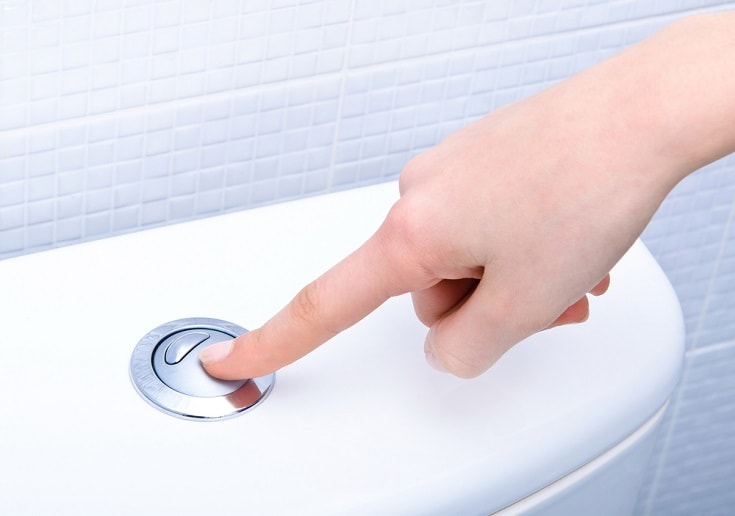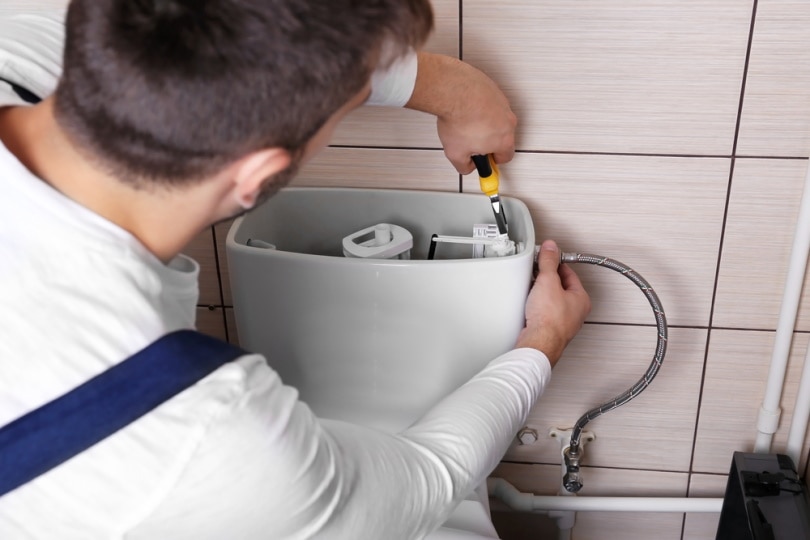My Toilet Whistles When I Flush: Reasons & Fixes
-

- Last updated:

Toilets typically make various sounds during & after flushing, but we are so used to the sound that most of us don’t even register it anymore. However, the toilet whistling after flushing is not normal and is something you should be concerned about.
The whistling sound can be pretty irritating, and it could escalate if you don’t fix the issue. It might even lead to water overflowing or leakage, resulting in more water usage and higher utility bills.
If you want to know more about why your toilet could be whistling after you flush and what you can do about it, this article is for you.
Why Is My Toilet Whistling?
There are several reasons why your toilet might be whistling. Sometimes, the whistle sound is so low that you barely hear it, while other times, it’s so loud that it is impossible to miss.
A metal ballcock valve blockage is the most common reason your toilet could be whistling after you flush. This valve floats when the toilet tank is full and falls as the water level drops after flushing. When the tank gets refilled, and the water level rises again, the valve closes, and no more water is allowed to get in.
If the valve deteriorates due to age or a malfunction, your toilet might begin to whistle after you flush. The whistling sound is caused when the armature and ball in the ballcock valve vibrate after the tank refills. Additionally, the fault might be with the ballcock. It’s also important to note that the louder the whistling sound, the bigger the problem is.

Some other reasons why your toilet could be whistling include:
- Leaking valve
- The fill valve might be blocked by debris
- Buildup in the pipes from calcium deposits in the water
When Should I Be Concerned?
Most people only get concerned once the whistling noise is too loud to ignore.
If your toilet is whistling, take it as its cry for help. It may represent a more imminent failure and should be handled immediately. Simply adjusting the valves and pipes in the toilet might be enough to fix the whistling problem. However, to prevent this from happening again, get a professional plumber to do it.
How to Fix a Whistling Toilet
Many homeowners often ignore the issue and choose to deal with the irritating noise generated by the whistling toilet later. However, this only works in the short term, so it’s vital to fix the problem as soon as possible. Failure to do so will only worsen the issue over time, and it will cost significantly more to fix.
The good news is that it’s pretty easy to fix once you know what you’re looking for. You can choose to do this by yourself or get a plumber to deal with the problem. If you decide to fix the whistling problem on your own, start with the following.
1. Check the Water Supply Valve
The main purpose of the water supply valve is to ensure that water flows inside the toilet tank. If it is damaged, loose, or malfunctioning, it might stop water flow, leading to a whistling noise when flushing. To locate this valve, feel behind the toilet close to the wall—that way, you can tell if it leaks.
To ensure that the valve is open, turn it counterclockwise. If the whistling sound doesn’t stop after doing this, you might have to check inside the toilet tank; that might be the source of the problem.

2. Check the Fill Valve
The fill valve or the gasket is the next culprit for a whistling toilet, especially if your toilet is an older model. Toilets with metal gaskets tend to have this problem.
The valve is usually on the left rear corner of the toilet. To diagnose the problem, flush the toilet with your ear close to it. If the noise comes from the fill valve, the next course of action will be to check if there is any buildup using a sponge or a damp towel. If there is a buildup, remove it, then try flushing again. If the whistling sound is still there, consider getting a professional plumber.

3. Replace the Fill Valve
Depending on the extent of damage to the fill valve, you might have to replace it entirely instead of simply changing a few parts. Plastic valves are easier to remove than metallic ones found in old toilet models.
If the problem is with the fill valve, replacing it can prevent your toilet from whistling after flushing in your next flush.
- Remove the lid from the toilet tank
- Shut off the water valve by turning it clockwise
- Flush the toilet and drain out all the water in the tank
- Disconnect the water supply tube to ensure that no more water enters the tank
- Remove the old, malfunctioning fill valve and replace it with the new one
- Flush the toilet to ensure that there is no whistling noise

What Do I Need to Fix a Whistling Toilet?
If you are into DIY, you might already have all the tools needed to fix your toilet. In case you don’t, a simple trip to the local hardware is enough. You can purchase everything you need to fix your whistling toilet, including a new fill valve, rubber gaskets, and a wrench. Ensure you have a complete list of the necessary equipment before visiting the store.
How Much Does It Cost?
Fixing a whistling toilet is pretty inexpensive. If you do the fixing yourself, all you need to spend money on are the tools and replacement parts, which should be $20–$40 on average. If you hire a professional plumber, the cost can come up to $200 for the parts and labor, which can be a bit too expensive for some homeowners.

Conclusion
You might think that your toilet whistling after flushing is not a big deal, but it could be a sign of a bigger problem. The last thing you want is to find your toilet flooded and, even worse, the entire house. It also saves you more money to deal with the issue as soon as you spot it.
Dealing with your toilet’s plumbing is not always a fun project, and it can get quite messy. Therefore, you should consider hiring a professional plumber to do it for you to avoid further damage to your toilet and bathroom.
Featured Image Credit: son Photo, Shutterstock
Contents

